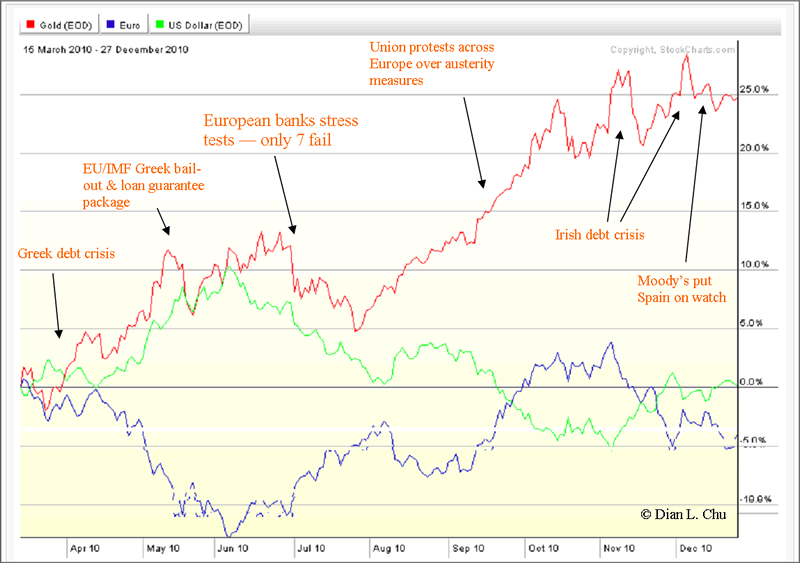Results 1 to 1 of 1
Thread Information
Users Browsing this Thread
There are currently 1 users browsing this thread. (0 members and 1 guests)
-
12-30-2010, 03:21 AM #1Senior Member


- Join Date
- May 2007
- Location
- South West Florida (Behind friendly lines but still in Occupied Territory)
- Posts
- 117,696
Gold, Dollar, Euro & China: Four To Tango in 2011
Gold, Dollar, Euro & China: Four To Tango in 2011
Stock-Markets / Financial Markets 2011
Dec 29, 2010 - 03:28 PM
By: Dian_L_Chu
For the most part of 2010, the typical image of Europeâone of cultural sophisticationâhas been replaced by widespread riots, burning cars, large scale strikes over labor reform and unemployment resulting from austerity measures amid a sovereign debt crisis in the region.
Gold Chartâs European Tale
Fear about defaults and more bailouts throughout the European Union (UN) has formed a dark storm cloud hanging over the otherwise robust global rally, and pushed Gold to an all-time high of $1,432.50 an ounce on Dec. 7.
The marketâs emotion related to the European debt crisis is clearly reflected through the interaction between Dollar, Euro and Gold, where you can literally trace the timeline of significant macroeconomic events in Europe and the United States (See Chart).

The general pattern is simple - Whenever thereâs bad news out of Europe, investors first course of action is to dump Euro and go into gold and dollar as the two top safe haven choicesâ¦. and vice versa.
Conventional Wisdom Rewritten
Historically, gold is seen as the ultimate hedge against inflation and dollar weakness with a typical inverse relationship with the U.S. dollar. Meanwhile, Euro had been gaining on the dollar as the choice of global reserve currency over the past decade mostly on concerns over the mountainous debt of the U.S. government.
However, the conventional wisdom has been totally rewritten by the global financial crisis, the European debt crisis, and the unprecedented and synchronized global quantitative easing. As horrendous as the U.S. budget deficit and debt situation is, compared with the depth and breadth of European debt woes, investors now see euro as the risky currency, while dollar has regained its safe haven status as Gold.
China In The Gold House
So, how will the dynamics between Dollar, Euro and Gold play out in 2011?
At current price levels, the main gold buying action will come from investors and funds as inflation and currency hedge as well as price speculation, instead of from jewelry demand. From that perspective, thereâs a fourth major player, in the name of China, emerging in the global gold market.
Bullion Vault noted that with savings-deposit rates now more than 2% below the rate of consumer-price inflation, China has fast become the world's No.2 source of physical gold demand. In fact, China recently revealed that its gold imports rose almost 500% year-over-year to 209 tons during the first ten months of this year.
Chinaâs Surging Gold Trade
Peopleâs Daily Online also noted the explosive growth in China's private gold investment market. In the first three quarters, the individual customers in Shanghai Gold Exchanges neared 1.6 million; gold trade exceeded 4,600 tons and its turnover topped 1.1 trillion Yuan, both rising sharply. That means Chinese has traded more gold than the total global identifiable demand (about 3,201 tons) over the first nine months of the year.
Love of Gold â A Chinese Tradition
The surge in China gold demand seems to have befuddled some including Richard Daughty (aka The Mogambo Guru) at The Daily Reckoning who wrote ââ¦there is nothing about Chinese trusting gold for the last few thousand years or so.âJoin our efforts to Secure America's Borders and End Illegal Immigration by Joining ALIPAC's E-Mail Alerts network (CLICK HERE)


 LinkBack URL
LinkBack URL About LinkBacks
About LinkBacks




 Reply With Quote
Reply With Quote

PHOTOS: Bidens Released Migrants Still Camp on Streets of El...
05-04-2024, 04:01 PM in illegal immigration News Stories & Reports